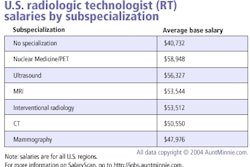Fibers on her father's clothes netted one college professor $3.8 million dollars. A 39-year-old accountant, who helped his father install drywall as a kid, feathered his own nest with $3.6 million. A former U.S. Navy shipman served his country and banked $7.4 million.
All of these people were diagnosed with mesothelioma, a malignant cancer caused by asbestos exposure, according to the law firm that posted these wins on its Web site.
While asbestos exposure is undeniably harmful, is every individual who comes across asbestos likely to have a fatal disease? The results of radiographs play a major part in determining if a plaintiff has a serious medical problem, not to mention a case for compensatory reimbursement.
Under U.S. law, people who claim occupationally related respiratory disease or disability (impairment of pulmonary function, mesothelioma, asbestosis) must support their case with a posteroanterior (PA) x-ray, read by physicians certified by the U.S. government, or B readers. The B Reader Certification Examination is offered by the National Institute for Occupational Safety and Health (NIOSH).
A recent study in Academic Radiology caused a brouhaha when it strongly suggested that B readers, who may render a potentially life-altering verdict on asbestos exposure-related radiographs, were not always on the up and up with their diagnoses.
To recap, Dr. James Gitlin and colleagues at Johns Hopkins Medical Institutions in Baltimore found that medical experts commonly used by plaintiffs' attorneys routinely identify abnormalities on chest x-rays at a rate far higher than that of independent radiologists.
Gitlin's group amassed 551 chest radiographs that were deemed positive for lung changes by initial B readers retained by plaintiffs' attorneys. Six chest radiologists and pulmonologists agreed to reinterpret the x-rays.
The six independents were also certified B readers, but they were seeing these particular films for the first time, Gitlin told AuntMinnie.com. The study results are based on a dataset of 492 film readings by the B readers and 2,952 interpretations by the consultants.
According to the results, the initial readers interpreted x-rays as positive for parenchymal abnormalities in 95.9% of the 492 cases. In contrast, the six consultants classified the films as positive in 4.5% of their readings.
As for pleural abnormalities, 26.4% of the B readers answered "yes" to the question "Any Pleural Abnormalities Consistent with Pneumoconiosis?" versus 7.6% of the independent readers. 72.8% of the B readers answered "no," versus 87% of the independent readers.
The discrepancies were too great to be mere coincidence, raising "the question of whether objectivity and truthfulness among certain B reader radiologists have been supplanted by partisanship and ... departure from the truth driven by financial gain," Dr. Murray Janower wrote in an accompanying editorial (Academic Radiology, August 2004, Vol. 11:8, pp. 843-856).
The question remains, what is the source of these discrepancies? "The B reader test, for all its flaws, is still the world's standard," said Otha Linton, an original creator of the B reader program, executive director of the International Society of Radiology in Bethesda, MD, and co-author of the Academic Radiology study.
"If you hold (B reader certification) and still have such a discrepancy in your classifications, is there something wrong with the test? Or is there something wrong with the use of your skills as a B reader?"
B readers' history
According to the criteria explained on the NIOSH Web page, B reader "approval is granted to physicians who demonstrate proficiency in the classification of chest x-rays for the pneumoconioses using the International Labour Organization (ILO) classification system."
The ILO system serves as a guideline for B readers to record their asbestos-related findings, including small opacities associated with parenchymal changes and their profusion, based on a 12-point scale (from 0/- for normal lung up to 3/+ for advanced disease). In 1980, the ILO deemed that a grade of 1/0 indicated pneumoconiotic changes on x-ray, which was enough to justify a compensation claim.
Any physician can be certified as a B reader, although imaging is the specialty of the majority. An informal AuntMinnie.com check on the 462 current certified B readers found that 284 are listed as radiologists, diagnostic radiologists, or imaging specialists. Eighty-three specialize in pulmonary medicine, either alone or along with critical care medicine, internal medicine, and occupational medicine. The remaining 95 are in nonpulmonary or nonimaging fields.
But this isn't necessarily a problem, Linton pointed out. Passing the NIOSH B Reader Certification Examination is hardly a walk in the park.
"The passage rate is about 50%. Not to say that everyone who passes it is a superexpert, but it does say that you have met a minimum standard," Linton explained.
The B reader exam is offered every month at the Appalachian Laboratory for Occupational Safety and Health (ALOSH) in Morgantown, WV. Readers are required to recertify every four years.
There are two ways to prepare for the B reader exam. One option is a self-study with the NIOSH syllabus. The second is to attend the Symposium on Radiology of the Pneumoconioses sponsored by the American College of Radiology (ACR). The most recent symposium was held in March 2004 with about 175 attendees, according to an ACR spokesperson. Session topics included reading film and CT for coal and silica, as well as a review of the ILO Film Classification System.
Radiologist Dr. Afzal Ahmed has been a certified B reader for nearly two decades at Princeton Community Hospital in Princeton, WV. He is one of seven B readers in his institution's 13-member radiology department. For Ahmed, becoming a B reader was a convenient necessity.
"This is an area where they have a lot of coal mines so we see a lot of patients with the clinical problems of pneumoconioses," he explained. "To take care of these patients, you need to have the clinical expertise in that area. And the (B reader) exam isn't give too far away from here in Morgantown." Ahmed estimated that he B reads close to 400 chest x-rays in a year, diagnosing pneumoconioses, due to coal dust exposure, in about 20% of the cases that he sees.
The legal viewpoint
The Academic Radiology paper was not the first to draw attention to this issue. In 1990, a study in the Journal of Occupational Medicine also reported a significant discrepancy between first and second reads of chest radiographs from tire workers, previously designated as having asbestos-induced conditions (November 1990, Vol. 32:11, pp.1088-1090).
The Academic Radiology study was spearheaded by Linton and David Setter, an asbestos-defense attorney at Socha, Perczak, Setter & Anderson law firm in Denver. Setter saw a recurring pattern in which plaintiffs' lawyers were repeatedly consulting the same B readers to examine and interpret x-rays.
Linton and Setter then teamed up with the group at Johns Hopkins in 2001 to see if the pattern was a continuing problem. Once again, they found that asbestos-related disease was diagnosed less often by the second readers than the B readers (Rocky Mountain News, August 9, 2004).
Needless to say, the results of the Gitlin study were not shocking news to legal experts who handle asbestos-related cases.
"It absolutely, unequivocally doesn't not surprise me," said H. Lane Young II, a partner in the Atlanta law firm of Hawkins & Parnell that defends asbestos cases. "We've won a number of cases by simply having our B reader put the plaintiff's x-ray next to a normal film, either an ILO 0/0 or 0/1, and they look exactly the same. Sometimes the plaintiff's x-ray is less subjective to a finding of infiltrates than that of an ILO normal film."
Of course, the argument can be made that if plaintiff's B readers are too liberal with their interpretations of chest x-rays, then B readers for the defense may be too conservative. But in his experience, that's not very likely, Young said.
"Our B readers' (interpretations) are much more in line with the (original) report from the people that did the x-ray. In a majority of lawsuits, the B read by the defense radiologist or pulmonologist is in line with that (first) review," he explained.
Those on the other side of the case, personal injury lawyers who specialize in asbestos cases, are not fazed by the results either. Dave Chervenick from the Pittsburgh law firm of Goldberg, Persky & White told Nature News that B readers used by his firm are hardly spotting mesothelioma on every film that comes their way. In fact, they generally find asbestos damage in only 15% of cases, he said (Nature.com, August 5, 2004).
Gregory Meronek, an associate at the San Francisco law firm of Carroll, Burdick & McDonough, said the B reader system is "a pretty good system. When it was first set up, it was quite an accomplishment to come up with a readily objective class for chest x-rays." Meronek specializes in medical and discovery aspects of toxic tort and asbestos litigation.
"The problem is that there is always going to be an element of subjectivity (to the B reader system)," he added.
And the Academic Radiology study highlights the possibility that subjectivity has overtaken objectivity. The study should inspire B readers to take a closer look at their motivations, Meronek said.
"I think it's a wake-up call to the radiology profession to really look at how the B reading process has been hijacked to some extent. That it's come to serve the interests of litigation versus an independent medical evaluation process," he stated.
So what might some of these "interests" be? The most obvious one is financial. Both sides pay B readers for their time and services. Meronek said his firm pays B readers anywhere from $300-$500 per hour, depending on their level of experience and time constraints. But is that enough to inspire a biased read?
"The plaintiff's lawyers are looking for abnormal chest x-rays, and they are going to call certain B readers. If an attorney finds a B reader who is very 'friendly' and who tends -- either out of ignorance or a more nefarious motive -- to over-read, then that B reader's name is going to be well-known," commented medico-legal expert Dr. Leonard Berlin, who co-authored the Academic Radiology editorial with Janower.
"All of a sudden, that B reader is going to be called very frequently," Berlin added. "It's the same in all expert witness testimony."
But not everyone is convinced of the definitiveness of the Gitlin study. B reader Ahmed pointed out that agreement between the six consultant readers, on issues such as film quality, varied widely. Ahmed said that he also would like to have seen the the consultant readers reanalyze their own films (done as B readers) to see if they had a tendency to over-read as well.
If anything, the paper emphasizes a weakness in the B reader system rather than the readers themselves, according to Ahmed.
"When B readers take the NIOSH test, it's not a very objective examination. It's very subjective examination in terms of what you call a read finding," he said. "The best way to achieve the most accurate results is to do a side-by-side comparison of standard (ILO) films with the x-rays. The chances of you making a mistake are much less. Still, you are dealing with two lawyers, two physicians, and two sides to every story. There is always going to be a difference of opinion."Updating the ILO
In 2000, the revised edition of the "Guidelines for the Use of the ILO International Classification of Radiographs of Pneumoconioses" was released. Starting in March 2004, NIOSH began revamping the entire B reader program and incorporating the revisions. Once this process is done, NIOSH will test new B reader candidates, while current B readers will have to recertify under the new system.
Simultaneously, Linton and his colleagues are stumping for legislation called the "Fairness in Asbestos Injury Resolution Act of 2003" (S.1125). The FAIR Act of 2003 includes provisions that would penalize fraud and false statements submitted by those seeking restitution from the Asbestos Injury Claims Resolution Fund.
Will the B reader program eventually graduate to using other imaging modalities or other kinds of tests? One possibility is matching an x-ray exam with a nonimaging study, such as a pulmonary function test, Linton said.
For the time being, the program is sticking with the basics. On the NIOSH Web site, an acknowledgement of the advent of digital radiography is posted, but it asserts that "the ILO International Classification of Radiographs of Pneumoconioses prescribe side-by-side viewing of subject and standard radiographs, and state that the standard films take precedence in defining profusion categories." Until provision for digital images are in place, traditional screen-film will remain the standard.
In the meantime, there are suggestions for tackling the B reader system from other angles. Ahmed said his group already performs either a consensus panel read, or a double-read, of x-rays sent by lawyers.
Both Young and Meronek told AuntMinnie.com that one possibility would be retooling it to eradicate the issue of partisanship.
"I think the solution would be to... have a blind read by a group of court-appointed radiologists in a particular state," Young said. The x-ray would be submitted to a radiologist from a panel group, who wouldn't know for which side (plaintiff or defense) he or she was reading, Young explained. And the radiologist "would be paid through some court fund to which the plaintiffs and defendants could contribute."
As for other modalities, most asbestos-related cases already involve a CT scan, although it is not officially sanctioned by NIOSH.
"I know there's been discussion about how high-resolution CTs are a much more effective tool than chest x-rays," Meronek said. "The only problem is that you don't have anywhere near the same degree of objective criteria. As long as you have any element of subjectivity, there's always going to be that danger that there will be considerations other than just film interpretation."
Creating such objective criteria would require a major overhaul to the B reader system. Unfortunately, large governing bodies such as the ILO don't enact change very swiftly.
"Changes can only occur when there is agreement at the international level," said certified B reader Dr. James Reed, a professor of diagnostic radiology at the University of Louisville in Kentucky. "(ILO) is resistant to the inclusion of CT or conversion to digital (x-ray), which is a problem for most university centers in the U.S. But we have little influence on these large bureaucracies."
By Shalmali Pal
AuntMinnie.com staff writer
September 7, 2004
Additional reporting by Lopa Pal.
Click here for "Part II: A survey of asbestos-related imaging."
Related Reading
Court allows suit over radiologist's findings in pre-employment x-ray, August 20, 2004
Study sounds alarm over integrity of expert readers' testimony, August 6, 2004
ACR expels member for improper lawsuit testimony, July 9, 2004
Separating inflammation from malignancy on thoracic FDG-PET, April 9, 2004
Asbestos-related cancer on the rise in UK, February 2, 2004
Copyright © 2004 AuntMinnie.com



















